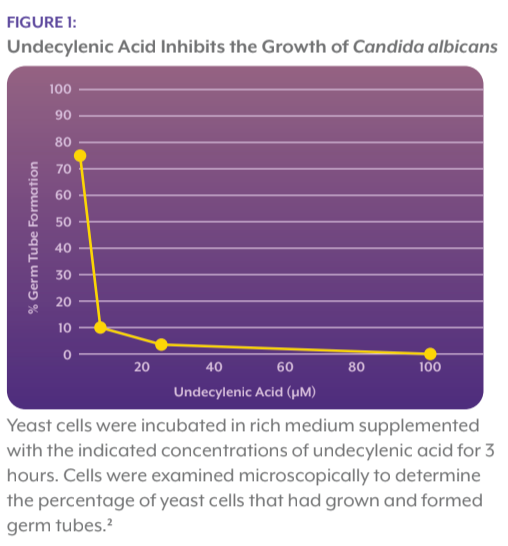Using antifungal herbs or medications is a common approach to dealing with Candida overgrowth.
Most practitioners incorporate some direct antifungal strategies in their protocols.
Some new conversations are emerging with regard to a “smarter” approach to dealing with Candida overgrowth.
Sooner or later, “crowding” out yeast with probiotics or prebiotic strategies, can be a necessary and often missing piece of the puzzle.
So here are some reasons why your “kill” strategy may not be working as well as you would like.
Problems with a Candida Killing Strategy
1.) Biofilm.
Biofilm is a matrix-like substance produced by microbes. The easiest example of a biofilm is dental plaque – the filmy white stuff that can build on your teeth that is produced by the overgrowth of oral bacteria.
Candida can also produce biofilm.
Most notably, the biofilm can hide the organism from the internal immune system. Moreover, it can block outside agents, whether prescription or botanical, from working effectively.
So while a killing strategy can be an important first step in healing – make sure you address the potential for biofilm as well.
Monolaurin is not only an anti-Candida extract, but it also is a Candida biofilm disruptor by at least two separate mechanisms. I like using it when yeast is suspected for these reasons. Many know monolaurin solely as an antifungal supplement.
The other reason I like monolaurin is that fungal overgrowth does not always occur in isolation.
Fungal growth often occurs because of immune imbalance – this immune imbalance can lead to bacterial overgrowth, and also viral overgrowth. Monolaurin happens to be one of the most powerful natural agents to support healing from viruses such as Epstein Barr, Herpes Simplex, Cytomegalovirus, and others.
These viruses are commonly associated with fatigue, autoimmunity, and gastritis, and more. Of course, all of these symptoms can overlap with the symptoms of fungal overgrowth.
Monolaurin covers all of these bases with one substance and can be a “multiplier” on other aspects of your protocol to help them work more effectively.
Other biofilm-disrupting substances may include N-acetyl cysteine, activated charcoal, proteolytic enzymes, and others. Monolaurin has been specifically studied with Candida biofilms too. I use Ultralaurin by Inspired Nutrition.
My next favorite is Candidase-PRO by Enzyme Science, as it contains high-dose cellulase which helps dissolve components specific to fungal cell walls. This can help break open the fungal cells, but also help to mop up the waste when other agents kill the organism.
2.) Fungal growth embeds itself into the intestinal lining via “hyphae” (pronounced “hi-fee”).
Candida produces root-like structures called hyphae that help the organism embed itself to the lining. When this happens, it can disrupt the health of the gut lining and make the body prone to inflammation.
The root-like structures can also make Candida growth more difficult to treat.
Luckily, some natural agents also help to specifically disrupt these fungal roots. Undecylenic acid as found in MegaMycobalance, is what I use most.
Undecylenic acid has been shown to block the growth of Candida by reducing the ability to form these root structures (see figure).

Megamycobalance combines undecylenic acid with bee propolis. Bee propolis is one of the more powerful antimicrobial substances in nature.
Bees line their hives with propolis (via their spit), and the substance contains numerous plant extracts.
This powerful mix protects the hive from infections that could lead to colony collapse. We can leverage the power of bee propolis for our own antimicrobial needs.
Miles MR, Olsen L, Rogers A. Recurrent vaginal candidiasis. JAMA. 1977;238:1836- 1837. & Koç AN, Silici S, Kasap F, et al. Antifungal activity of the honeybee products against Candida spp. and Trichosporon spp. J Med Food. 2011;14(1-2):128-34.
3.) Using prescription or natural antifungals long-term may hurt levels of healthy bacteria and yeast.
Many of the same herbs that kill Candida, will kill healthy bacteria and yeast too.
We know that bacterial overgrowth often happens alongside Candida, so generally, some extra antimicrobial activity is a good thing.
It’s when this is the only strategy being used long-term (usually >90 days) that it becomes a problem.
We also know that the overgrowth can be comprised of otherwise healthy microbes, such as Lactobacilli species.
Botanicals are often more selective than prescription antimicrobials, or at least can often be used in conjunction with them to improve outcomes.
Sooner or later, changes will still need to be made to the diet, and a probiotic or prebiotic strategy will need to be initiated to enact real, lasting change.
If you focus on “kill, kill, kill” strategies for Candida – you chance disturbing the overall intestinal environment – and the microbiome is not given a chance to recover, nor can it sustain itself.
-
- Instead, I add healthy bacteria to help “crowd out” fungal growth naturally either at the start of a protocol or at least by three weeks into a killing strategy.
- I then wean the client off the killing products and branch more into the “crowding” out and flora-rebuilding strategy. Sooner or later, a kill strategy needs to transition to a microbiome restoration and sustaining strategy.
Remember, some intestinal Candida is normal and healthy for the gut. Lactobacilli species are also normally very healthy for us. Killing them completely presents separate challenges.
Like Candida, when Lactobacilli organisms are overgrown, they can be enemies before they become friends.
Overgrowth can happen when there is dietary excess of carbohydrates, sensitive or allergic foods, or from general immune suppression from some sort of outside stress. Overgrowth can also be relative to the health of other healthy microbes.
When key groups of microbes such as Bifidobacteria, Akkermansia muciniphila, or Faecalbacterium prausnitzii are deficient, Lactobacilli and Candida ratios naturally become higher. You can target these bacteria with supplementation (Trubifido), or with use of a precision prebiotic like MegaPrebiotic (now in prebiotic capsules too). I also like Sunfiber powder for a popular and well-tolerated way to support keystone bacteria.
Problems with Candida overgrowth:
1.) Fatigue
2. ) Leaky gut, endotoxemia, and systemic inflammation that can affect brain, skin, and joints
3.) Increased susceptibility to other infections
4. Often present alongside small intestinal bowel overgrowth (SIBO), which can commonly be associated with Lactobacilli overgrowth
Problems with Lactobacilli overgrowth:
1.) Fatigue from excess levels of D-lactate, which gunks up our cellular energy production.
2.) Anxiety, diarrhea, headaches, and more, from an overproduction of intestinal histamine. Histamine intolerance is most commonly a result of the overgrowth of small intestinal bacteria. It can also be complicated by genetics, as an individual can be slow to metabolize intestinal histamine in the first place – such as SNPs in DAO, HNMT, or ABP-1 genes.
3.) Lactobacilli can be more immune-stimulating than other types of bacteria – and you can promote an overzealous immune response and be more sensitive to autoimmune-like flare-ups.
Your immune system is divided into three groups.
You have Th1 cells, Th2 cells, and regulatory or chaperone cells that keep the Th1 and Th2 in check.
Someone with an autoimmune disease can have imbalances in any of these three areas. I think about it best as a “seesaw” with Th1 on one side, and Th2 on the left side.
Vitamin D3, antioxidant systems, and microbiome diversity work together to protect this balance.
Lactobacilli tend to tilt this seesaw too much in the short term, which can cause flare-ups over the first 3-7 days of supplementation. It can also help calm down flare-ups depending on how someone’s seesaw is tilted. You often do not know until you give a Lactobacilli-containing supplement a trial.
Candida overgrowth also works to put this Th1/Th2 seesaw off-balance.
Worse yet, when the entire microbiome is disrupted, you lose out on the benefits of immune training and mucosal protection.
Unfortunately, when this happens the whole cycle goes awry until the body goes into hyperdrive with inflammation, and starts attacking otherwise healthy tissues.
If you are also actively killing off bacteria with botanicals or medication during this time – it can be a lot for your body to contend with. But choosing these options may be a necessary evil.
Supporting Lactobacilli and Fungal Overgrowth Naturally
I normally focus on boosting non-Lactobacilli species first, in case overgrowth is present.
Later on, I’ll use TruFlora as a cleansing probiotic (especially competitive with yeast growth) once someone’s immune system is “ready” for it.
There are times that I may be comfortable using Lactobacilli right out of the gate, but no harm is done by starting elsewhere and coming back to these strains.
Before then, I’m using Megasporebiotic, RestorFlora, Trubifido, or Theralac, generally in that order over the course of the first 3-6 months. Then I’ll finish things off with some Truflora.
Experts readily admit that even the best protocols will often take 6-9 months to really revamp someone’s gut health, and my approach is indicative of that timeline.
I’ve detailed this more directly in my Probiotic Blueprint.
Every case is a bit different but these guidelines can surely get you a few steps further – or at least help you understand where and when your protocol may have gone off-course.
A Step-by-Step Candida Overgrowth Protocol:
 Step 1:
Step 1:
Rid the body of overgrowth over a three week to three month period of time, and sometimes longer if someone is especially sensitive – such as with chronic lyme disease or chronic mold exposure.
If you’re unsure, seek medical testing to confirm Candida is an issue in the first place. For proactive and long-term analysis, use organic acid testing, and personalized microbiome analysis such as BiomeFx.
BiomeFx is home stool testing that can be done on your own to evaluate the health of your microbiome – with personalized tips, strategies and supplement recommendations included in the detailed report.
Step 2:
Circle back to replenish deficient flora that may be allowing the overgrowth to happen in the first place. I often start Megasporebiotic and TrubifidoPRO as early as Step 1.
Promote mucosal health so the bacteria have a healthy place to bind, feed, and live.
In the long-term, the mucosa and flora work together to support the health of one another. By promoting the health of one, you’re promoting the health of the other.
Step 3:
Use prebiotics or diet to resupply the fuel sources for these flora, to prevent deficiencies from happening again long-term and to lessen dependence on supplements to maintain healthy gut function.
I gently introduce these sources slowly, by focusing on prebiotics that support a narrower spectrum of flora, and eventually introducing more broad-spectrum prebiotic supports.
As I talked about in part one, introduce dietary prebiotic starches and fibers slowly, one by one, starting low with dosage and working up as the body tolerates.
Pay careful attention to how your gut responds when introducing new products. Prebiotics can promote the growth of unwanted microbes when they are already overgrown – if you react poorly to some probiotics – you may be going too fast.
You want to find the balance of pressing the accelerator down hard enough – but not so much that you’re flaring yourself up in a counterproductive way.
These probiotic and prebiotic steps are outlined in the Probiotic Blueprint.
If overall digestion, inflammation, and motility are concerns, and you still run into problems tolerating a protocol, I recommend checking out: The 7 Core Strategies to Heal the Gut Lining and Manage Leaky Gut Naturally.
How Might a “Smarter” Candida Strategy Look?
 I like to add competing flora alongside anti-candida supplements.
I like to add competing flora alongside anti-candida supplements.
Supplements are typically taken in addition to a Candida-starving Diet, such as a low-FODMAP, and if that’s not enough, a GAPS Diet or Specific Carbohydrate Diet protocol.
- For direct antifungal support, I like to add Monolaurin for the first month or two until I get a handle on the overgrowth.
- While in this “killing phase”, I also use MegaMycobalance which is a combination of Bee propolis and undecylenic acid from castor bean.
Fungi attach to the intestinal wall via structures called “hyphae” (pronounced “hi”-”fee”). Megamycobalance was designed to support healthy yeast levels in the intestinal environment.
Undecylenic acid in MegaMycobalance has the ability to disrupt the fungal hyphae (roots or “germ tubes” as they are referred). Bee propolis is a powerful and wide-spectrum antimicrobial that bees use to line their hives to protect the colony from microbe invasion.
- I will start with the spore probiotic called Megasporebiotic which lives in the small intestine where Candida overgrowth most often occurs.Megaspore produces natural antimicrobial compounds and will directly inhibit Candida growth and steal real estate away from the harmful yeast in the small intestine.
- Check out the Megasporebiotic Resource Guide for full details on our most recommended product including correct intake instructions.
- Review the Megasporebiotic Leaky Gut Study
- Megasporebiotic and Megaprebiotic Synbiotic Study
- I will also add a healthy probiotic yeast known as Saccharomyces boulardii. I use RestorFlora also made by Microbiome Labs. Klaire Labs Saccharomyces boulardii is another option enjoyed by my clients.
- It can be important to simultaneously support mucosal health as healthy bacteria and yeast need a healthy home to live and feed.MegaMucosa combines key amino acid building blocks, immunoglobulins, and bioflavonoids that work together to support a healthy mucosal lining.MegaGuard is also useful as a mucosal support, motility aid, and antimicrobial. It contains anti-inflammatory licorice flavonoids, as well as artichoke leaf extract, and high potency ginger extract.The licorice and artichoke leaf ingredients support inflammation and mucosal health, and the gingerols have known anti-Candida properties (https://www.ncbi.nlm.nih.gov/pmc/articles/PMC6121036/).
Use intestinal lining supports like L-Glutamine and Zinc Carnosine to support mucosal healing. For more rampant inflammation, consider using curcumin such as the highly bioavailable Theracurmin HP.
I also like Lion’s Mane – a medicinal mushroom that protects nerve health and can help with mental focus and cognition.
As the gut is lined with nerves known as the enteric nervous system, I believe Lion’s Mane mushroom to be an overlooked powerhouse.
- As symptoms improve over a period of one to three months, slowly re-integrate previously restricted foods as talked about in Part 1.
The combination of Megasporebiotic, RestorFlora, Monolaurin, and MegaMycobalance allows you to take advantage of multiple anti-Candida mechanisms. Each presents unique hurdles to the fungal growth. For even more botanical support, consider Candidase Extra Strength by Enzymedica
The products work in synergy over the first one to three months of a protocol.
Dealing with Fungal Die-off Symptoms
As you kill fungal cells, you can experience “die-off” – a sudden increase in fatigue, body aches, headache, mental fog, and more. “Die-off” occurs as your body deals with the cell debris and Candida toxins released by the physical death of the fungal cells.
If symptoms get worse when starting a protocol due to “die-off” – you’re on the right track! Symptoms may be a sign that you should integrate the products more slowly, starting with a low dose and adding products one at a time.
If die-off is too strong from this strategy, I may add a high Cellulase and Protease enzyme supplement like Candida Control by Enzyme Science.
The high levels of cellulase and protease help to digest the cell wall components and proteins specific to Candida and fungi – as they are comprised differently than bacterial cells.
Take the enzymes between meals, so that the enzymes focus on digesting the cell components – and not food digestion.
I also will use Mega IgG2000 by Microbiome Labs which contain immunoglobulins (IgG) that physically bind cell debris and microbial toxins. Natural IgG levels can be deficient in the midst of chronic inflammation and microbiome imbalances.
Summary Plan – a Smarter “Killing Phase”:

- Monolaurin (pellets / capsules)and Megamycobalance (Undecylenic acid and Bee propolis) are direct anti-Candida agents. The combination addresses fungal overgrowth and biofilm by a number of mechanisms for a more complete approach to growth inhibition. For even more support add Candidase Extra Strength.
- Megasporebiotic (spore probiotics) and Restorflora (Saccharomyces boulardii AND extra spore probiotics) are probiotic strategies to add good flora & help naturally crowd out bad flora like Candida overgrowth – while also enhancing the balance of healthy flora.
- Address mucosal and inflammation support as needed to give the new probiotics a healthy place to live. MegaMucosa, MegaGuard, L-Glutamine, Zinc Carnosine, Theracurmin HP, and Lion’s Mane are choices that I turn to most often.
- When dealing with “die-off” – the first recommendation is to slow down the strategy and work at a pace that your body allows. Supplementally, use Candidase PRO or other high-cellulase supplement to mop up wastes.
IgG-Boost 2500 Immunoglobulin Powder by Doctor Alex Supplements or Mega IgG2000 by Microbiome Labs can also be used for bacterial and fungal die-off. The immunoglobulins physically bind an array of unwanted toxins.
- You want to transition any killing strategy into a probiotic/prebiotic strategy in one to three months, and sometimes six months or longer for sensitive individuals who must progress very slowly or risk triggering a flare-up as well as episodes of mental fogginess or fatigue.
In Part One, I discussed the problematic nature of a long-term starvation approach to killing Candida overgrowth.
In Part Three, I introduce a new concept of glycemic variability – which turns out also to be an effective antifungal strategy you can turn to long-term.





